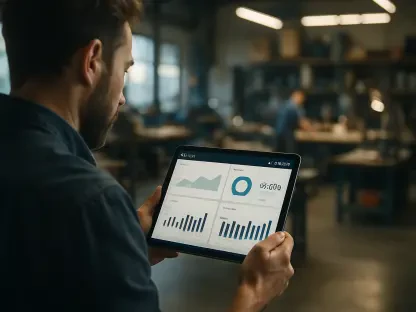The journey of personal banking has witnessed significant transformations over the decades. What began with the advent of Automated Teller Machines (ATMs) has now progressed into a world dominated by sophisticated digital solutions. This evolution underscores a persistent drive towards enhancing customer convenience and operational efficiency within the banking industry. As technology continued to advance, the banking sector adapted and innovated to meet the growing demands of its customers, ultimately transforming the way financial transactions are conducted today.
The Inception of ATMs
ATMs represented a major leap forward in banking technology. By providing 24/7 access to services such as cash withdrawals, deposits, balance inquiries, and fund transfers, ATMs drastically reduced the reliance on traditional bank branch hours and human tellers. These innovations fundamentally changed the way people conducted their banking activities, making essential services readily accessible. The impact of ATMs on customer service was profound, allowing customers to perform basic banking tasks with immense ease and convenience, leading to widespread adoption. The success and popularity of ATMs highlighted the potential of self-service banking solutions, paving the way for future digital advancements.
The widespread adoption of ATMs during their early stages speaks volumes about their success and efficiency. Their introduction not only revolutionized how individual customers accessed their finances but also signified a broader move towards decentralized banking services. Banks could now extend their services beyond the constraints of normal business hours and physical locations, significantly improving accessibility. This advancement marked the beginning of a new era where technology served as an enabler for unprecedented levels of customer convenience. The ATM technology laid the groundwork for further innovations, fostering a culture of constant improvement and customer-centric services in the banking sector.
The Rise of Online Banking
The next significant milestone in personal banking came with the introduction of online banking. This innovation allowed customers to manage their accounts, transfer funds, pay bills, and access a myriad of banking services from their homes. Online banking offered unparalleled flexibility and convenience, further reducing the dependency on physical bank branches. As customers experienced greater autonomy and control over their financial activities, the transition from physical to digital platforms solidified. Banks were able to reach and serve their clients more efficiently, heralding a new era of customer-centric services.
As online banking continued to develop, it evolved beyond simply replicating services offered through traditional branches. The platforms began offering unique features such as detailed account summaries, transaction histories, and customizable alerts, which provided customers with deeper insights into their finances. This new level of transparency and control fundamentally changed customer expectations and interactions with their banks. Institutions that embraced these technologies could deliver a more tailored, responsive, and user-friendly experience, thereby strengthening customer loyalty and satisfaction. Online banking also opened up opportunities for banks to operate with greater efficiency, resulting in cost savings that could be reinvested into further technological advancements.
Mobile Banking Revolution
With the advancement of technology, mobile banking emerged as a game-changer. Through mobile banking apps, customers could conduct virtually any banking task from their smartphones. This development further enhanced accessibility and convenience, catering to a tech-savvy customer base that prioritized speed and mobility. Mobile banking brought about numerous possibilities—customers could check account balances, transfer funds, deposit checks, and even apply for loans or credit cards without ever visiting a branch. This shift marked a significant step towards greater ingenuity in personal banking services.
The implications of mobile banking extend beyond merely offering convenience. The technology reshaped the entire financial ecosystem, creating new opportunities for service innovation and customer engagement. For instance, mobile banking apps often integrate features like account management tools, spending trackers, and financial advisories. These capabilities empower customers to make informed decisions about their financial wellness in real-time. Additionally, mobile banking’s ubiquity has spurred the development of seamless multi-channel strategies where users can effortlessly navigate between platforms—be it online banking, mobile apps, or even physical branches. Such synergy ensures a consistent and enriching customer experience, reinforcing the fundamental shift towards a digital-first banking environment.
The Emergence of Digital Payment Solutions
Parallel to mobile banking, there was a notable shift toward a cashless society through digital wallets and contactless payments. Payment methods like Apple Pay, Google Wallet, and banking apps offered quick, secure transactions. These innovations simplified the payment process while boosting security by mitigating risks associated with cash and physical cards. The move towards digital payment methods has accelerated the decline of cash usage, reflecting a broader trend within personal banking to embrace digital solutions that enhance customer convenience and safety.
Digital payment systems also contributed to reducing friction in everyday transactions. Their integration into e-commerce platforms and point-of-sale systems allowed consumers to complete purchases with unprecedented ease and speed. This ease of use encouraged a more fluid and instinctive financial interaction between consumers and businesses. The widespread adaptation of digital wallets underscored a fundamental transformation in consumer behavior—shifting from traditional cash-based transactions to embracing digital ecosystems. Furthermore, these systems provided the groundwork for innovations such as peer-to-peer payments, enabling instantaneous money transfers with minimal fees, thus broadening the scope and appeal of personal banking services.
Integration of AI and Machine Learning
The integration of artificial intelligence (AI) and machine learning technologies into banking services marked another pivotal development. AI-powered chatbots and virtual assistants now provide instant customer support and personalized financial advice. These tools replicate services traditionally delivered by human tellers, enhancing operational efficiency. Moreover, AI’s ability to offer tailored solutions to customers has significantly improved the overall banking experience. Financial institutions have increasingly leveraged these technologies to maintain a competitive edge and meet the evolving demands of their customers.
Efficiency gains driven by AI extend beyond customer interactions to encompass a broader range of banking operations. Machine learning algorithms can analyze vast amounts of data to detect fraudulent activities, assess risks, and inform strategic decision-making processes. Such capabilities allow banks to operate more securely and proactively, protecting customers’ assets and enhancing trust. Furthermore, AI-driven insights enable banks to personalize their product offerings, ensuring that customers receive financial services and advice that resonate with their unique needs and circumstances. Through these multifaceted applications, AI and machine learning continue to redefine the boundaries of what is possible within the banking sector, pushing the industry into new realms of service excellence.
Ensuring Cybersecurity and Collaboration with Fintech
The journey of personal banking has seen remarkable changes over the years. It started with the introduction of Automated Teller Machines (ATMs) and has evolved into an era driven by advanced digital solutions. This transformation highlights an ongoing effort to improve customer convenience and boost operational efficiency within the banking sector. As technology advanced, the banking industry responded by innovating and adapting to the increasing demands of its customers. Today, this evolution has completely redefined how financial transactions are performed, reflecting a significant shift from traditional methods to instant, digital services that cater to a tech-savvy population seeking speed, accessibility, and security in their banking experiences. The entire banking landscape has reshaped itself to meet modern needs, ensuring that customers benefit from seamless and efficient processes, ultimately enhancing their overall banking experience.









